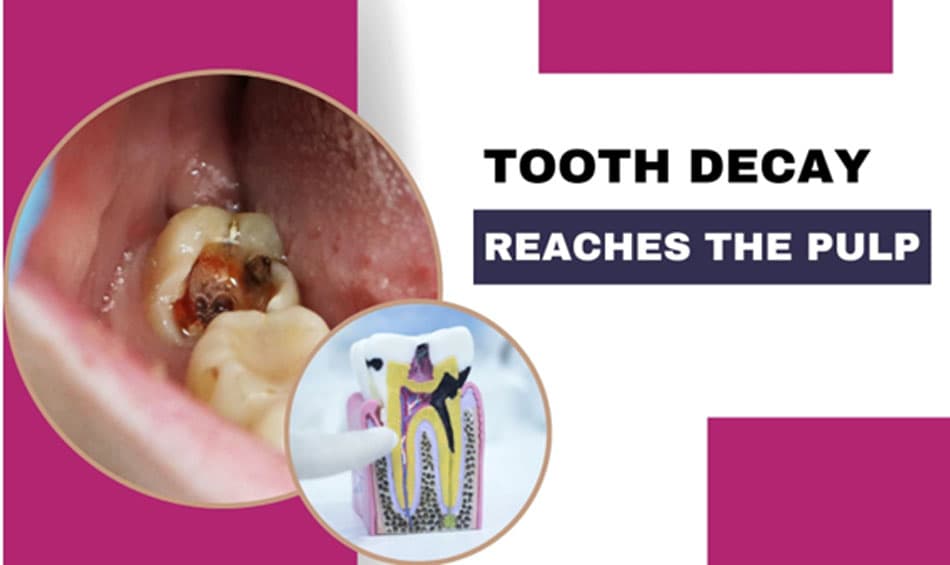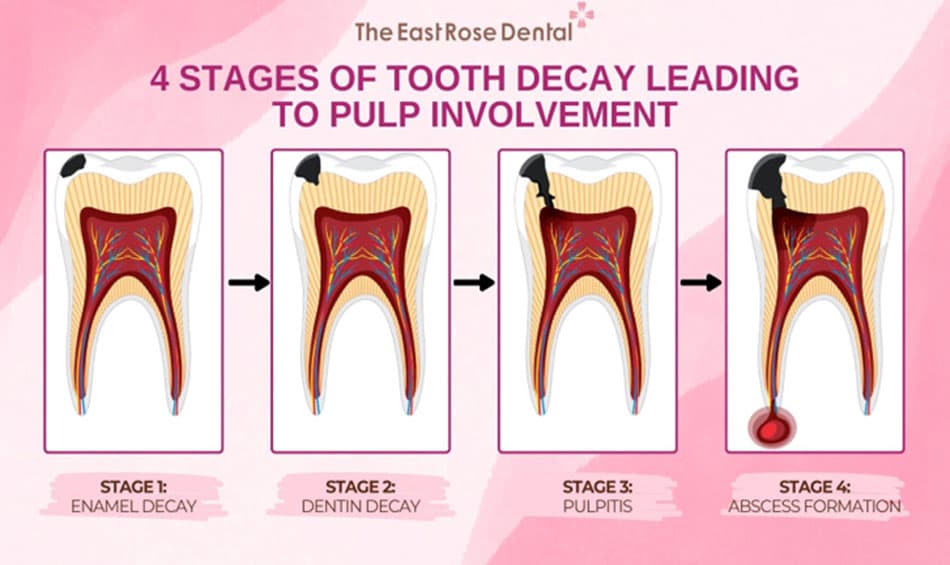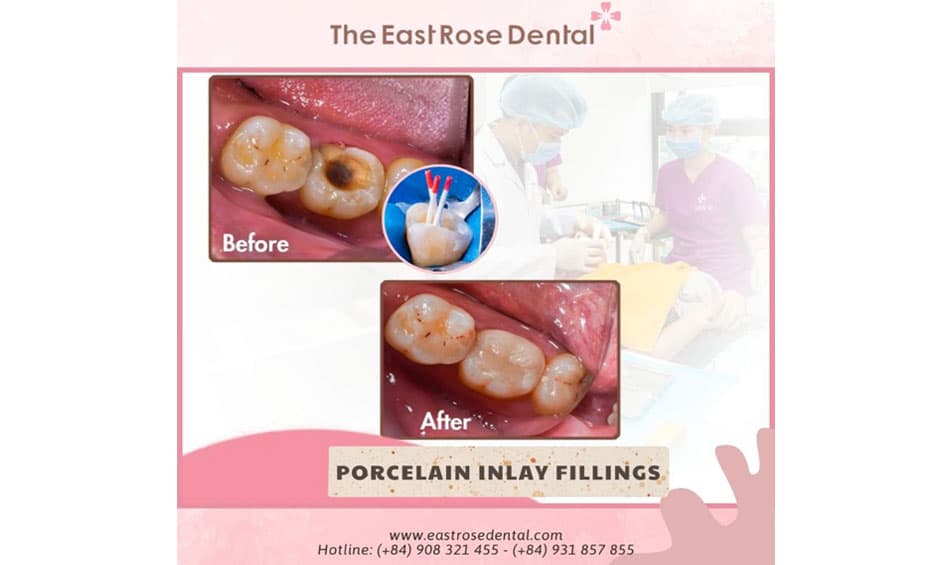Signs of Deep Tooth Decay into the Pulp and Timely Treatment Methods
Signs of deep tooth decay into the pulp are a serious condition that requires timely recognition and treatment. Many patients often overlook early signs, leading to severe and difficult-to-treat complications. Understanding this, The East Rose Dental Clinic has compiled a range of signs from simple to complex, helping you identify them early for effective treatment.

Understanding Deep Tooth Decay into the Pulp
Human teeth consist of three main layers: enamel, dentin, and pulp. Enamel is the outermost layer, hard and protective of the inner parts of the tooth. Beneath the enamel lies dentin, a hard but less durable layer compared to enamel. The pulp is the innermost part, containing nerves and blood vessels that nourish the tooth and sense pain when exposed to external stimuli.
When deep tooth decay is not promptly treated, bacteria can penetrate from the enamel through the dentin and eventually reach the pulp. Deep decay into the pulp causes intense pain, especially when eating or touching the affected tooth. Additionally, the tooth may become more sensitive to temperature, causing sharp pain when consuming hot or cold foods. Swelling around the affected tooth is also a common sign.
Signs of Deep Tooth Decay into the Pulp in 4 Stages

When tooth decay progresses without timely treatment, it can cause severe tooth damage, ultimately leading to pulpitis. Understanding the stages of cavity development helps you recognize and address issues promptly, effectively safeguarding oral health.
Stage 1 - Enamel Decay
Initially, tooth decay affects only the outer enamel layer of the tooth. At this stage, you may not feel any pain or noticeable symptoms, but small white spots or tiny black spots may appear on the tooth surface. Early detection and treatment at this stage make tooth restoration easier and less costly, preventing the decay from progressing to more severe stages.
Stage 2 - Dentin Decay
As bacteria continue to break down the enamel, they invade the dentin layer of the tooth. This stage often causes mild pain, especially when consuming sweet or sour foods. The tooth becomes more sensitive to hot and cold temperatures, resulting in sharp pain when eating or drinking. Without timely treatment, decay progresses, leading to more severe damage and affecting the tooth pulp.
Stage 3 - Pulpitis
Without treatment, tooth decay progresses into the pulp, which contains nerves and blood vessels. This stage causes intense and persistent pain. Inflamed and infected pulp can lead to swelling and the formation of pus around the tooth. Throbbing pain when chewing and increased sensitivity to temperature are common. This condition can lead to serious complications for the tooth and gums if not treated promptly.
Stage 4 - Abscess Formation
This is the most serious stage where infection spreads from the tooth pulp to surrounding tissues, forming an abscess. You may experience facial swelling, intense pain, fever, and fatigue. Without prompt treatment, the infection can spread to other areas of the body.
Timely Treatment Methods for Tooth Decay Reaching the Pulp
When experiencing tooth pain, a general examination by a dentist will determine the complexity of the issue. The treatment method varies depending on the condition of each patient:
- Early Detection Before Decay Reaches the Pulp: If detected early, the dentist will perform a filling or crown procedure. This involves cleaning the decayed area and using dental materials to fill or crown the tooth, preventing further decay and protecting the tooth structure.
- When Decay Reaches the Pulp: In this case, root canal treatment (RCT) is necessary. This process is more complex and requires a skilled dentist to thoroughly clean and treat the infected pulp causing pain.
- When Root Canal Treatment is Not Possible: If it is too late for root canal treatment, the tooth must be extracted. In this situation, the tooth is severely damaged and cannot be restored, making extraction necessary to avoid serious complications and to protect overall oral health.
Treatment Process for Deep Tooth Decay into the Pulp at The East Rose Dental Clinic
The treatment process is carried out professionally and meticulously at our dental clinic to ensure the highest treatment efficacy. Let's explore the specific steps involved in root canal treatment, providing you with an overview and peace of mind when undergoing treatment at The East Rose Dental Clinic:
- Step 1 - Examination and Assessment of Tooth Decay: First, the dentist will thoroughly examine and evaluate the stage of tooth decay. They will determine the appropriate treatment plan, including whether a root canal is necessary.
- Step 2 - Preparation: After deciding on a specific treatment plan, the dentist will administer local anesthesia to the affected tooth to ensure you don't feel any pain. A mouth guard will be used to protect the tooth from bacteria in saliva and to keep you comfortable throughout the procedure.
- Step 3 - Accessing the Pulp Chamber: Once the area is numbed, the dentist will drill a hole on the top of the tooth to access the pulp chamber and root canals. Using a microscope and bright light, they will clearly see inside the tooth and remove any damaged soft tissue.
- Step 4 - Cleaning and Disinfecting: The empty space inside the tooth will be thoroughly cleaned with water and antibacterial solutions to ensure the root canals are completely sterile. If necessary, the dentist will apply an antibacterial medication to eliminate any remaining bacteria.
- Step 5 - Sealing the Pulp Chamber and Filling the Tooth: After cleaning and disinfecting the root canals, the dentist will fill them with a suitable dental material. Sealing the pulp chamber with a special material and filling the tooth will prevent infection and restore the tooth's function.
- Step 6 - Post-Treatment Follow-Up: After the root canal treatment, the dentist will schedule follow-up appointments to monitor your recovery, usually requiring at least 2-3 sessions. For more severe cases, ongoing monitoring and treatment may be needed over several months.
Common Questions About Deep Tooth Decay into the Pulp

The issue of deep tooth decay into the pulp is quite common, so The East Rose Dental Clinic often receives related inquiries. Below are some common questions and answers compiled from our team of dentists.
Is treatment for deep tooth decay into the pulp painful?
The process of treating deep tooth decay into the pulp typically isn't painful because our team of dentists uses local anesthesia to numb the area. After treatment, you may experience some discomfort, which usually diminishes gradually and can be managed with pain relievers prescribed by your dentist.
How long does it take to treat deep tooth decay into the pulp?
The treatment time for a tooth with deep decay typically lasts about 60-90 minutes per session. To complete the treatment process, you will need at least 2-3 sessions. For severe cases, post-treatment monitoring can last from 2-3 months according to the doctor's treatment plan. Close monitoring and timely treatment ensure your tooth is fully restored and prevent possible complications.
How much does it cost to have a root canal for deep tooth decay?
The cost of treating tooth decay reaching the pulp varies depending on the location of the tooth, the severity of the condition, and the dental clinic you choose. On average, the cost ranges from $65 to $175 per tooth, depending on which tooth is affected. You should refer to the specific price list at Oriental Rose Dental Clinic for the most accurate information.
Can deep tooth decay into the pulp be filled?
When a tooth is affected by deep decay into the pulp, a simple filling typically isn't sufficient to address the issue. Instead, you will need a root canal treatment to remove the infected pulp, followed by filling or crowning the tooth to protect it after treatment.
- For cases where re-filling is possible: When root canal treatment has been completed and the tooth has been tightly sealed, and there is sufficient structural integrity and durability, re-filling the tooth is feasible. Additionally, if there is not excessive structural loss due to decay or root canal treatment, re-filling the tooth is entirely feasible.
- For cases where re-filling is not possible: If the tooth has suffered excessive structural loss, is compromised, or the root canal was not completely sealed, re-filling is not a viable option. In such cases, the dentist may need to place a full ceramic crown or extract the tooth for replacement with an implant, restoring both function and aesthetics.
Why does deep tooth decay into the pulp often hurt more at night?
Tooth decay reaching the pulp typically causes more pain at night because when lying down, blood flow to the head increases, exerting more pressure on the inflamed area, thus intensifying the pain. Additionally:
- During sleep, physiological activities such as chewing, swallowing, and talking decrease, reducing the ability to eliminate waste and bacteria from the decayed tooth area, leading to increased inflammation. Moreover, secretion tends to accumulate during sleep, increasing pressure and stimulating the tooth pulp area, causing pain.
- Pain from tooth decay reaching the pulp tends to worsen at night, causing sleep disturbances and exacerbating discomfort. Sleep deprivation and stress due to pain also contribute to increasing pain levels.
See more customer experience videos at East Rose Dental Clinic
The signs of deep tooth decay into the pulp have been detailed by The East Rose Dental Clinic in this article. Understanding and timely detection are crucial to protecting your oral health. If you experience any of these symptoms, visit a dentist promptly for examination and treatment to prevent potential serious complications.
For dental checkup & consultation with dentist at The East Rose Dental
- Click here to book an appointment online directly : https://eastrosedental.com/en/contact.html
- SMS, Viber, Zalo, Whats App, Skype: +84 90 8 321 455
- Hotline: (+84)908 321 455 - (+84)931 857 885
The East Rose Dental – Since 2000 – Top 2nd - All On 4 Vietnam
➮ Clinic District 2: 166 Dong Van Cong, Thanh My Loi Ward, District 2, Ho Chi Minh City (adjacent to Vista Verde apartment).
➮ Clinic District 1: 30-36, 2nd floor Phan Boi Chau, Ben Thanh Ward, District 1, Ho Chi Minh City (at the East Gate of Ben Thanh Market).
Services
Working Time
- Monday - Friday: 08:00 - 19:00
- Saturday: 08:00 - 18:00
- Sunday closed
Contact Info
- Hotline 1: (+84) 908 321 455
- Hotline 2: (+84) 931 857 885
- Mobile: (+84) 8 3925 8778
- Phone: (+84)2 838 258 778
- info@dentalrose.net
- rosedentalclinicvn@gmail.com
 English
English  Tiếng Việt
Tiếng Việt

